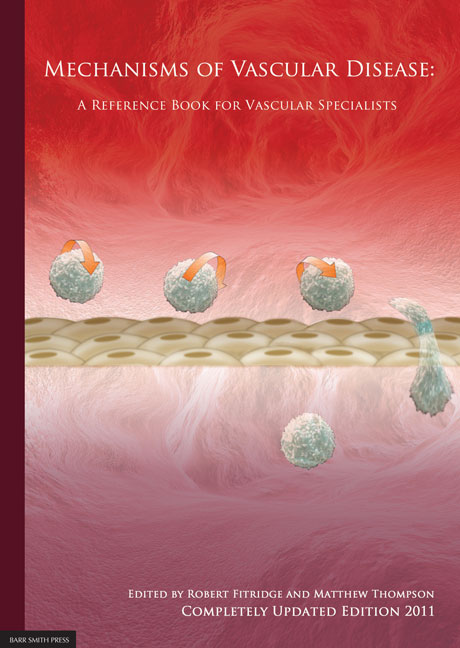Book contents
- Frontmatter
- Contents
- List of Contributors
- Detailed Contents
- Acknowledgements
- Abbreviation List
- 1 Endothelium
- 2 Vascular smooth muscle structure and function
- 3 Atherosclerosis
- 4 Mechanisms of plaque rupture
- 5 Current and emerging therapies in atheroprotection
- 6 Molecular approaches to revascularisation in peripheral vascular disease
- 7 Biology of restenosis and targets for intervention
- 8 Vascular arterial haemodynamics
- 9 Physiological Haemostasis
- 10 Hypercoagulable States
- 11 Platelets in the pathogenesis of vascular disease and their role as a therapeutic target
- 12 Pathogenesis of aortic aneurysms
- 13 Pharmacological treatment of aneurysms
- 14 Pathophysiology of Aortic dissection and connective tissue disorders
- 15 Biomarkers in vascular disease
- 16 Pathophysiology and principles of management of vasculitis and Raynaud's phenomenon
- 17 SIRS, sepsis and multiorgan failure
- 18 Pathophysiology of reperfusion injury
- 19 Compartment syndromes
- 20 Pathophysiology of pain
- 21 Post-amputation pain
- 22 Treatment of neuropathic pain
- 23 Principles of wound healing
- 24 Pathophysiology and principles of varicose veins
- 25 Chronic venous insufficiency and leg ulceration: Principles and vascular biology
- 26 Pathophysiology and principles of management of the diabetic foot
- 27 Lymphoedema – Principles, genetics and pathophysiology
- 28 Graft materials past and future
- 29 Pathophysiology of vascular graft infections
- Index
29 - Pathophysiology of vascular graft infections
Published online by Cambridge University Press: 05 June 2012
- Frontmatter
- Contents
- List of Contributors
- Detailed Contents
- Acknowledgements
- Abbreviation List
- 1 Endothelium
- 2 Vascular smooth muscle structure and function
- 3 Atherosclerosis
- 4 Mechanisms of plaque rupture
- 5 Current and emerging therapies in atheroprotection
- 6 Molecular approaches to revascularisation in peripheral vascular disease
- 7 Biology of restenosis and targets for intervention
- 8 Vascular arterial haemodynamics
- 9 Physiological Haemostasis
- 10 Hypercoagulable States
- 11 Platelets in the pathogenesis of vascular disease and their role as a therapeutic target
- 12 Pathogenesis of aortic aneurysms
- 13 Pharmacological treatment of aneurysms
- 14 Pathophysiology of Aortic dissection and connective tissue disorders
- 15 Biomarkers in vascular disease
- 16 Pathophysiology and principles of management of vasculitis and Raynaud's phenomenon
- 17 SIRS, sepsis and multiorgan failure
- 18 Pathophysiology of reperfusion injury
- 19 Compartment syndromes
- 20 Pathophysiology of pain
- 21 Post-amputation pain
- 22 Treatment of neuropathic pain
- 23 Principles of wound healing
- 24 Pathophysiology and principles of varicose veins
- 25 Chronic venous insufficiency and leg ulceration: Principles and vascular biology
- 26 Pathophysiology and principles of management of the diabetic foot
- 27 Lymphoedema – Principles, genetics and pathophysiology
- 28 Graft materials past and future
- 29 Pathophysiology of vascular graft infections
- Index
Summary
INTRODUCTION
The introduction of prosthetic grafts has revolutionised the management of vascular disease but graft infection although uncommon, remains a dreaded complication With associated significant morbidity and mortality. Mortality occurs in approximately one third of all vascular graft infections, with mortality highest when an aortic prosthesis is involved. As many as 75% of survivors of an infected aortic prosthesis require amputation of a limb, with the incidence of amputation highest when the infection involves more distal prosthetic grafts. The incidence of graft infections is difficult to quantify as infection may manifest many years after implantation with many reports being isolated or as part of case series. Nevertheless, the reported incidence is in the order of 5%, varying according to the site of operation, being higher when a groin incision is used, or if the procedure is an emergency or a redo procedure. Infection following endovascular stent deployment has been reported although its incidence is considered to be very low.
NATURAL HISTORY OF PROSTHETIC VASCULAR GRAFT INFECTIONS
Early prosthetic vascular graft infections typically occurring in the first four months following placement are relatively uncommon (approximately 1%) and are usually caused by the more virulent micro-organisms, such as S. aureus, E. Coli, Pseudomonas, Klebsiella, Proteus and enterobacter. Late prosthetic vascular graft infections are the result of two possible mechanisms. Firstly, by haematogenous seeding from a septic focus elsewhere or by the prosthetic graft becoming infected with enteric contents following a graft-enteric erosion.
- Type
- Chapter
- Information
- Mechanisms of Vascular DiseaseA Reference Book for Vascular Specialists, pp. 537 - 548Publisher: The University of Adelaide PressPrint publication year: 2011
- 5
- Cited by



